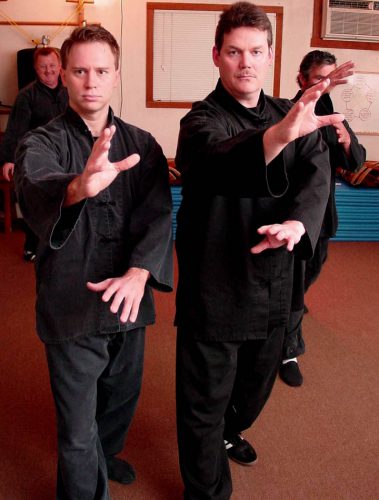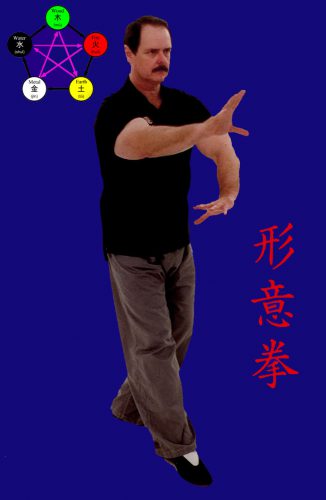 What is Xingyiquan?
What is Xingyiquan?
Li Family Xingyiquan
The Gompa Xingyiquan Program
Level One / Jiankang Calming Mind & Body Zhan Zhuang and Santishi
The Five Fists of Xingyiquan
Creating The Forms
Level Two – Tui-Shou Xingyiquan
Level Three – Zhandouli-fa Xingyiquan
What is a Qualified Xingyiquan Instructor?
Health Benefits of Xingyiquan
Can You Learn Xingyiquan On-Line
Clothing for Training Xingyiquan
What is Xingyiquan
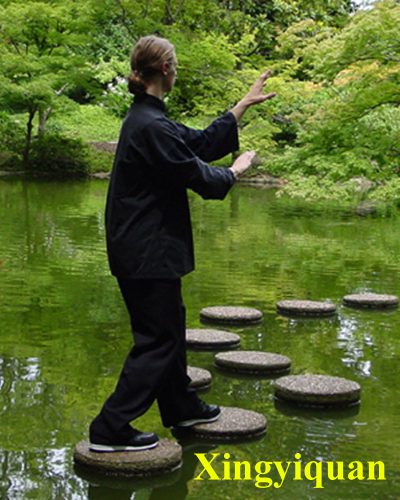 Xingyiquan or Hsing-I chuan pronounced (sing-e-chwen), is a Chinese internal martial and health art classified as one of the Daoist Wudang styles. The name of the art translates approximately to “Form of Intention Fist”, or “Shape of Will Fist”.
Xingyiquan or Hsing-I chuan pronounced (sing-e-chwen), is a Chinese internal martial and health art classified as one of the Daoist Wudang styles. The name of the art translates approximately to “Form of Intention Fist”, or “Shape of Will Fist”.
The name Xingyiquan implies a method of mind and body energy to create health or physical actions that can defeat an opponent in battle. Each of the three main Chinese internal martial arts of Taijiquan, Baguazhang and Xingyiquan has their own distinct characteristics and flavor.
Xingyiquan is the most direct practice of these arts as it is primarily composed of only five basic fist movements. Xingyiquan is characterized by seemingly linear movements that develop an explosive power most often applied from a short range. In the martial usage a practitioner of Xingyiquan uses coordinated movements to generate bursts of power intended to overwhelm the opponent, simultaneously attacking and defending.
Xingyiquan movements derive their names from the Chinese traditional medical (TCM) concepts of the Five Qualities (Wuxing) which are Metal – Water – Wood – Fire – Earth. These names relate to states of energy or force used in the martial art and health aspects. The Five Qualities are also know as the Five Elements and are a part of acupuncture and herbal theory in TCM. Using this connection the art becomes more than just a self- defense method it can also be used as a very powerful health and longevity exercise and a form of Daoist psychology as well. For this health development concept the same movements found in the martial art forms are used as a form of moving yoga (Daoyin) to reduce stress, increase circulation and improve longevity.
Li Family Xingyiquan
Master Li, Long-dao said their family originated from China’s Sichuan province around the famous Emei Mountain. Li Family Xingyiquan is known as a “family style”. Some methods of Xingyiquan have, “gone underground” to become what is commonly called secret or closed school or clan (Mi-Zhong). Closed or family styles were martial arts practiced within a particular clan of blood related family or secret society. Such styles were methods developed by a martial arts master from existing methods or newly created concepts learned from observing nature or studying strategy.
Such systems were practiced for the health and defensive skills of the members and were not shared with outsiders. Family styles were also developed by a clan who specialized in protective work like the caravan guards (baobiao). Some of these family styles have eventually become publicly taught systems while still others remain untouched and unknown to outsiders for hundreds of years as did the Li family style of Xingyiquan until Dr. John Painter began publicly teaching it in 1972 at the first Gong Fu School to be founded in Texas.
Li family method, one art with many names
As succeeding generations of teaches have added and subtracted their personal concepts to the Li family methods the art has been known by different names within the family. Xingyiquan was introduced to the Li family’s martial system by Master Li, Zhang-fu around the eighteen hundreds. Li, Zhang-fu reputedly learned the system on mount Emei and adapted it to fit the family needs. The families’ first name for their Xingyiquan method was Form of Mind Lightning boxing (Xingyiquan Shandian) and it appeared to be an interpretation of the Shansi style of Xingyiquan. Later the art was called Five Qualities Natural intention fist boxing (Wuxing Ziran Xingyiquan) by Master Li, Ren-ma.
During the 1930’s prior to the families exodus from China into Taiwan and later to the United States their methods appear to have absorbed concepts derived from intention boxing (Yiquan) created by famous master Wang, Xiangzhai. There are suspicions but no clear indication from my research that the Li family learned directly from Master Wang. These additions involved a number of standing and moving martial and health Qigong practices often called stand like a post (Zhan Zhuang). The Zhan Zhuang is used as both a health and form of combat preparatory meditation.
While Li Family Zhan Zhuang exercises are similar they are not exactly the same as those used in the art of master Wang, Xiangzhai. At any rate the final result was a family (personal) style of Xingyiquan which the last Chinese master, Li, Long-dao, Dr Painter’s teacher, named natural shape of intention boxing (Ziran Xingyiquan). Master Long-dao said. “Be simple and natural in your actions. Move like lightning, hit like thunder and disappear like clouds.”
This history as related is at best vague and unclear so please take it with a grain of salt. It is taken from sketchy notes made by Dr. Painter’s when he was 13 years old. Experience with the Chinese internal arts teaches that in the final analysis what an art can do for you in the present is much more important than from whom or from whence it originated.
The Gompa Xingyiquan Program
Our Xingyiquan course has three distinct levels so that anyone from 8-80 can study the art in a manner suiting their personal needs. You can learn the form only for health and stress relief in level one. After that if your interests run to the self-defense aspects we can train you in the protective countermeasures of Xingyiquan methods with the level two intermediate and level three advanced Xingyiquan courses.
Level One / Jiankang Calming Mind & Body
All courses begin with three basic methods, quiet sitting, daoyin and standing practice. These three foundational practices prepare the mind and body for the development of what the Chinese masters call internal strength (Neili) the hallmark of all Chinese internal martial arts.
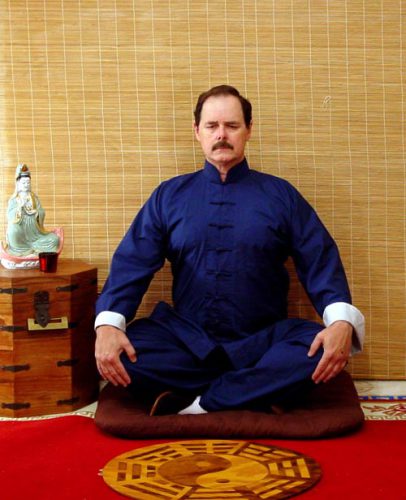 Quiet Sitting
Quiet Sitting
At the beginning of class students need time to unwind from the day. We use a technique called quiet sitting to do this. Quiet Sitting is just that, sitting down and remaining quiet for a short period of time. The method also uses Qigong (breath work) to develop natural relaxed breathing that improve circulation, calm the nerves and lower blood pressure. The Gompa method of quiet sitting helps prepare the mind and body for the practice of Xingyiquan. Quiet sitting is also used to enhance the minds ability to focus and extend concentration for the development of internal power.
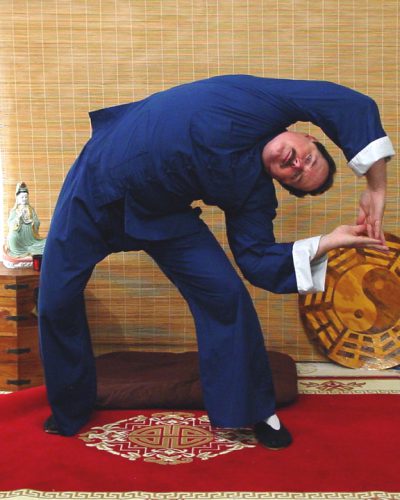 Daoyin
Daoyin
Easy motions, such as shoulder circles, turning the head from side to side, or rocking back and forth, help you to loosen your muscles and joints, relieve stress and focus on your breath and body. The Chinese call these pre-exercise movements Daoyin which means to use the mind to lead and guide movements carefully. Daoyin helps improve body awareness and increases nerve transmission from the brain to skeletal muscles.
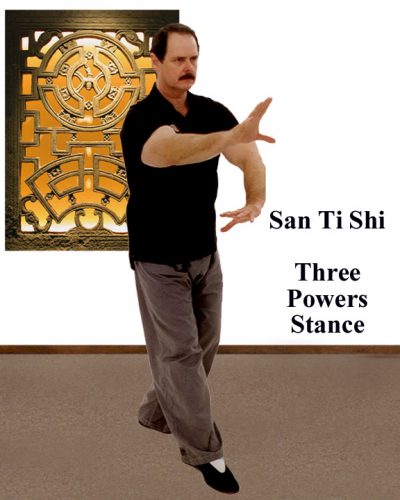 Zhan Zhuang and Santishi
Zhan Zhuang and Santishi
Students begin learning a powerful standing meditation method called standing like a post (Zhan Zhuang) to understand how to control the body for health and self- defense and to build up internal energy. After this initial training at the very heart of Xingyiquan is the standing form calledtrinity posture (Santishi). Santishi is an advanced form of Zhan Zhuang in that it is a static standing posture, with arms extended. Santishi is the foundation of all power training in Xingyiquan, and without it the training of the Five Elements forms for self defense could easily become nothing more than movements with minimal power.
Santishi also teaches how to calm ones mind and how release unnecessary stress. The process that Santishi sets in motion for balance, health and healing is expanded and fulfilled in the Five Element practices. Consistent practice of Santishi helps connect the muscles, bones. Ligaments, tendons and nervous system into one unified whole for the production of whole body power.
Jiankang in Chinese means health practice. This first program focuses on using Xingyiquan methods of Quiet Sitting, Power Standing and the Xingyiquan forms for health only. Scientific research has shown daily practice to be capable of stimulating the central nervous system, lowering blood-pressure, relieving stress, enhancing vascular circulation, increasing joint flexibility, improving lymphatic circulation and gently toning muscles without strain or high impact on the joints.
Each of the five movements as related to the TCM concepts of acupuncture and Qigong are explained in the health course as related to the acupuncture meridians, times of day for energy flow, color visualizations and much more making this a complete health course program based on tried and proven concepts from ancient knowledge.
Level one can be taken as a stand alone program designed to impart the knowledge and skills needed to use this art for developing health and stress relief. If you wish only the health benefits and no interest in the self-defense aspects you need go no further in your studies than level one. However this course is a required entry level program training the Li family Xingyiquan forms that will impart the core knowledge necessary for developing the skills presented in the two martial art courses.
The Five Fists of Xingyiquan
Xingyiquan only contains five movements, to the untrained observer they appear simple, while in reality it is an extremely complex art whose waters run deep. Students of the Li family Xingyiquan are taught five individual fundamental postures that are linked into a longer form, each can be used as an offensive and defensive tactic and also as a method of increasing circulation and health in the internal organs. Here is a sample of the benefits of each of the five fist martial art exercises and health benefits to be derived from their practice.
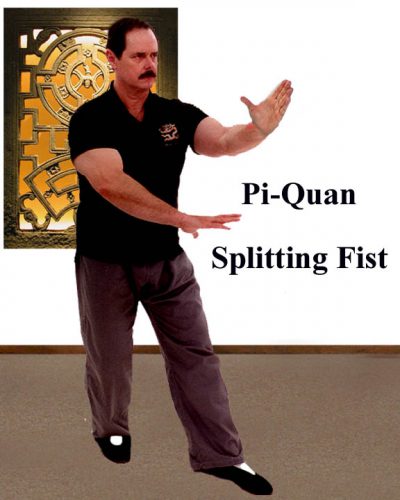 Splitting Fist – Pi Quan
Splitting Fist – Pi Quan
Pi means to divide, split or wedge and because the movement mimics a person chopping with an ax it is also called the Metal Fist. The movement splitting fist is that of the two hands rising and falling like chopping with an axe. In martial applications the palm is used in a down and forward cutting manner and may be applied as a neutralizing motion to stop punches or kicks or as a catching action, strike or arm lock.
For health purposes the action, when done correctly, is said to have an effect on the health of the lungs and the large intestine. This is partially due to the fact performing Piquan correctly compresses the upper thoracic cavity in the downward move and stretches the lower abdomen in the upward phase increasing circulation by this action.
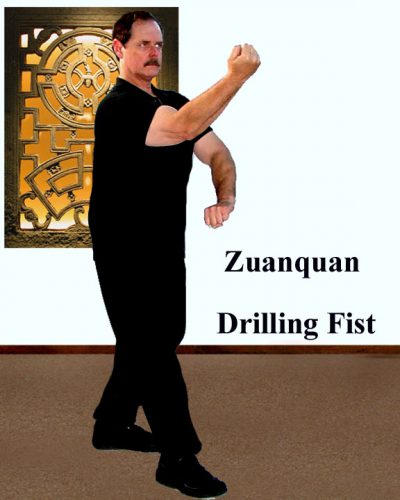 Drilling Fist – Zuan Quan
Drilling Fist – Zuan Quan
Zuan means to drill or bore into something.
Drilling fist in Xingyiquan is comprised of one hand rising the other falling. The symbolic concept of this movement is that of an ocean wave about to crash onto the shore so the form also has the name of Water fist. The martial action is that of a slantingly rising upward punch that drills into the opponents’ body like a tsunami. It can easily uproot an attacker or flow around his defenses.
Zuan Quan when performed slowly and smoothly is said to affect the health of the kidneys and bladder partially due to the action of the arms as they simultaneously stretch and compress the torso during the action. Coupled with the correct breathing method during Zuan Quan the prostate in men and uterus in women can also benefited.
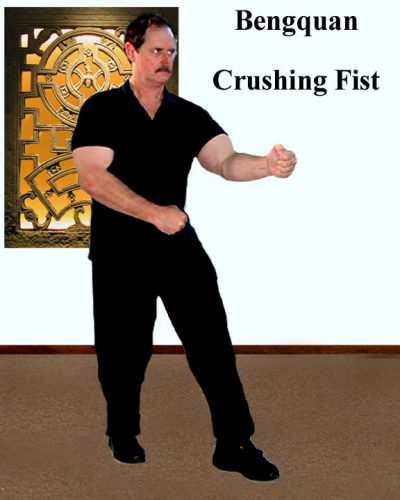 Crushing fist – Beng Quan
Crushing fist – Beng Quan
The name means to burst or crush with the fist. This movement is like an iron ball being projected straight forward into the target to break it apart. The tactic is also called Wood fist in its relation ship to the five qualities. One would not think of wood as bursting or crushing until you realize that a tree with its trunk, roots and limbs can over time split the earth and even rock. So wood has the quality of growing up, down and expanding outward.
For health and vitality (qigong) this form trained smoothly and evenly balances in the body/mind resulting in good decision making capability, a high-quality inner spirit and physical energy. Training Beng Quan with intent and fluid movement is said to energize the liver and gallbladder meridians as used in acupuncture. Its form is often compared to that of the bow and arrow. There is back and forward action in the bow to produce the straight flight of the arrow.
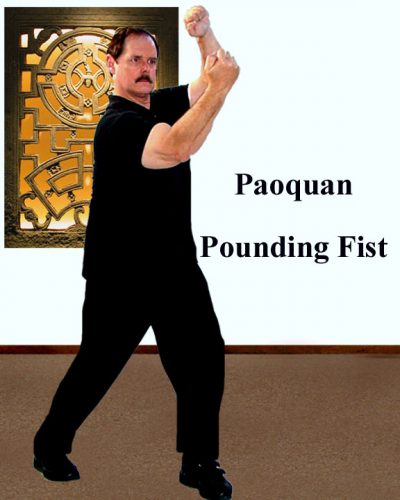 Pounding Fist – Pao Quan
Pounding Fist – Pao Quan
The attitudes relating to actions that explodes upward like a bomb or flames leaping to the sky. The form for Pounding makes use of a rising, rotating forearm to deflect incoming attacks, coupled with a powerful upward rising punch off the rear leg. It is related to the five qualities as fire this signifies the flash and bang of a cannon being fired and the fist is symbolic of the cannon ball pounding the intended target.
When fire energy is balanced the emotions are stable and clear. There is a balance between the intellectual mind (Yi) and the emotional mind (Xin). Correct practice is said to energize the heart & small intestine meridians used in acupuncture.
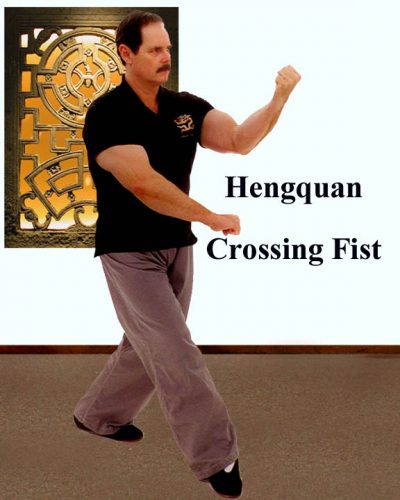 Crossing Fist – Heng Quan
Crossing Fist – Heng Quan
The feeling of stability within circular action is the hallmark of Heng Quan. The term literally means horizontal or crossing fist. In the art it is related to the qualities of earth which can absorb force and act as a foundation for powerful actions. Crossing, as a martial movement is a technique employing a rising, rounded energy moving from the inside outward that is well “grounded”. Its movements are capable of absorbing things as the earth soaks up water and attacking from unexpected angles.
Earth phase energy also relates to the planet earth and represents being emotionally and physically balanced. The earth turns rapidly on its axis like a gyroscope which creates its own field of internal balance or gravity. Therefore in Li family Xingyiquan earth energy relates to adapting to change without loosing one’s own center.
The action when done correctly is said to also have an influence on the Spleen and Stomach meridians used in acupuncture. Its twisting actions performed smoothly can also stimulate blood flow and lymphatic drainage of the torso and internal organs that are gently massaged by the action.
Creating The Forms
Once the student understands how to correctly perform each of the five actions the movements are then linked into a form (ding-li) to comprise a routine in which one action flows seamlessly into the next. The Xingyiquan ding-li has three forms in which the movements are linked in the respective order of the five qualities from the TCM chart of interconnection. They are called respectively the creative cycle, the sedation cycle and the neutral cycle. When one is able to grasp the basic principles of Xingyiquan these five movements can then be performed spontaneously without a pre-arranged connection. This is known as a dance of the fist (wu-quan) in which the art become form of “free style shadow boxing” designed to teach the health and combative concepts respectively. This is studied thoroughly in level three of the course program.
Level Two – Tui-Shou Xingyiquan
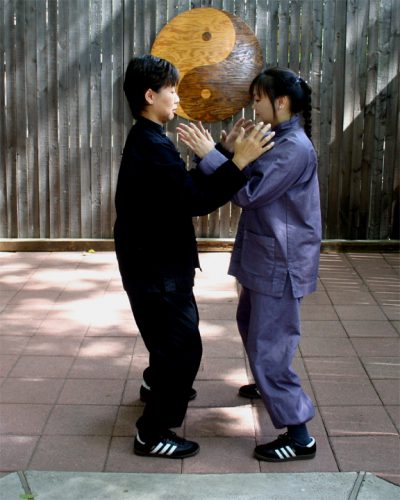 Tui-Shou means pushing hands and refers to special exercises designed to develop sensitivity and awareness in Xingyiquan for martial ability. The student of Xingyiquan is introduced to the soft style (internal) martial principles through a series of two person games and exercises known as Bending Willows. Other two person forms and games that make use of stepping patterns, neutralization of attacks and striking methods are learned to show how the Xingyiquan methods might work against an attacker.
Tui-Shou means pushing hands and refers to special exercises designed to develop sensitivity and awareness in Xingyiquan for martial ability. The student of Xingyiquan is introduced to the soft style (internal) martial principles through a series of two person games and exercises known as Bending Willows. Other two person forms and games that make use of stepping patterns, neutralization of attacks and striking methods are learned to show how the Xingyiquan methods might work against an attacker.
These methods are designed to take the student slowly through the basic physical and philosophical concepts these games not only teach how to deflect and neutralize physical attacks but their principles can also be applied to developing persuasive conversational skills for dealing with tense emotional situations.
Level Three – Zhandouli-fa Xingyiquan
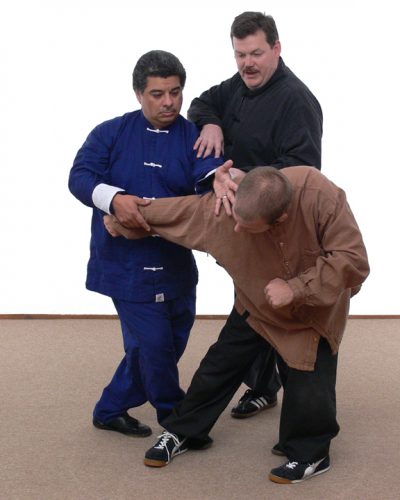 As a close quarter combative method Xingyiquan is one of the most effective of all the Chinese internal martial art styles. This level introduces the student to martial skills of Xingyiquan five fist forms for realistic self-defense applications.
As a close quarter combative method Xingyiquan is one of the most effective of all the Chinese internal martial art styles. This level introduces the student to martial skills of Xingyiquan five fist forms for realistic self-defense applications.
Our program draws upon the real life experiences of Dr. Painter as a police trainer and professional bodyguard and Shifu Alan Marshalls personal knowledge derived from using this art as the basis for training law enforcement with the American Rangers Law Enforcement Training Institute. You can be assured that your training will be derived from truly practical knowledge of Xingyiquan as a method of realistic self- defense.
Did you know that a condensed version of Xingyiquan was taught to Chinese officers at the Military Academy at Nanjing during the Second Sino-Japanese War for close quarters combat? This included armed techniques such as bayonet and sabre drills alongside unarmed techniques. Our martial program will show you how to discover the hidden combat principles, locks, throws, strikes, kicks and techniques of pressure point control and how to practice them safely with a friend. Size does not matter when one understands the principles of Li family Xingyiquan.
What is a Qualified Xingyiquan Instructor?
In our view it takes minimum of five years study to fully learn and understand the intricacies of Chinese concepts utilized in Xingyiquan. Teachers must know the writings of the early Chinese masters known as the Xingyiquan Classics; these classics explain the core principles of Xingyiquan. The classics are used as the basic foundation for all health and martial exercises found in every method or style. Instructors in our methods must be familiar with human anatomy, bio-mechanics and physiology as related to the health and safety of the exercises they will be teaching students. Our instructors are certified and rigorously tested over every aspect of the Li family Xingyiquan program before being allowed to instruct others.
Health Benefits of Xingyiquan
Xingyiquan Health Benefits
There is growing evidence that Xingyiquan used as mind-body practice has value in treating or preventing many health problems. You can begin Xingyiquan even if you aren’t in top shape or the best of health. Beginners learn the art as a low-impact, slow- motion exercise.
Xingyiquan differs from other types of exercise in several respects.
All movements are performed slowly at first and are never forced, the muscles are relaxed rather than tensed, joints are not fully extended or bent, and connective tissues are not overly stretched. Li family Xingyiquan can be easily adapted for almost anyone, from the very fit to people confined to wheelchairs.
Research and Evidence of Xingyiquan for Health
Muscle strength.
Standing training (Zhan Zhuang) when taught as the Li family method of intention attitude skill (Yixingong) has been shown to improve muscle strength in skeletal muscles by as much as 10% or more without performing progressive resistance exercises “weight lifting”.
Flexibility
The yoga (daoyin) methods used in our Xingyiquan are proven to improve join mobility and flexibility of the spine and limbs when performed with regularity.
Balance
Xingyiquan improves balance through improved proprioception — the ability to sense the position of one’s body in space. Proprioception declines with age but Xingyiquan helps train this sense, which is a function of sensory neurons in the inner ear and stretch receptors in the muscles and ligaments.
Aerobic conditioning
Depending on the speed and size of the movements, Xingyiquan can provide some aerobic benefits. One study showed that because Xingyiquan footwork stimulates the plantar fascia foot pumps daily training can improve vascular blood flow in the lower extremities resulting in a higher rater of oxygen being transported through the blood system. Those who want a more aerobic effect can simply perform the forms at a faster rate with deeper stances.
Can You Learn Xingyiquan On-Line?
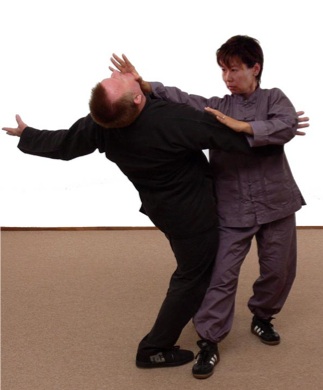 In a word no not correctly! Books and videos or DVD programs that purport to teach Xingyiquan on line or from a distance have flooded the market place in recent years. There is value in using these products as guides to help remind the student of lessons received in person from a real teacher. As far as actually learning the arts of Xingyiquan correctly without a teacher it is highly unlikely that any real progress can be made in this way. There are just too many factors, principles and concepts that need to be imparted through human touch.
In a word no not correctly! Books and videos or DVD programs that purport to teach Xingyiquan on line or from a distance have flooded the market place in recent years. There is value in using these products as guides to help remind the student of lessons received in person from a real teacher. As far as actually learning the arts of Xingyiquan correctly without a teacher it is highly unlikely that any real progress can be made in this way. There are just too many factors, principles and concepts that need to be imparted through human touch.
There are many styles, variations, and interpretations within these styles by individual teachers. If one does not know about these styles of Xingyiquan progress could be difficult if not impossible. Also some modern Xingyiquan forms can be damaging to the knees due to changes made for the sake of aesthetic appearance or teachers who modified the forms or who may not understand correct posture or bio-mechanics.
This poor understanding comes from a number of factors some of which include the teacher being self-taught and since there is no governing board of certification for Xingyiquan instructors, anyone can try to learn from a book or video and claim to be an instructor.
Even those who have learned from a Chinese teacher may not understand correct bio- mechanics because the teacher does not know anatomy and so the instructor may simply pass on so called ancient information that may in fact be damaging to the hips and knee structure especially in older individuals and this misinformation ends up in their books and videos.
Just because the teacher in a video or book is teaching Xingyiquan at a martial art school, hospital or health spa does not actually qualify him or her as an expert. Western medical facilities and doctors are no better than the general public when it comes to Chinese arts as far as they are concerned if it says Chinese martial arts on the business card then you must be an expert.
The instructors at The Gompa in Arlington Texas have 30+ years experience with traditional Chinese internal health and martial arts and they are required to be familiar with bio-mechanics, and sports medicine concepts. Each of our teachers’ forms is carefully examined to make sure all postures and movements are correct and within the safety limits of the human muscle and skeletal structures.
Clothing for Training Xingyiquan
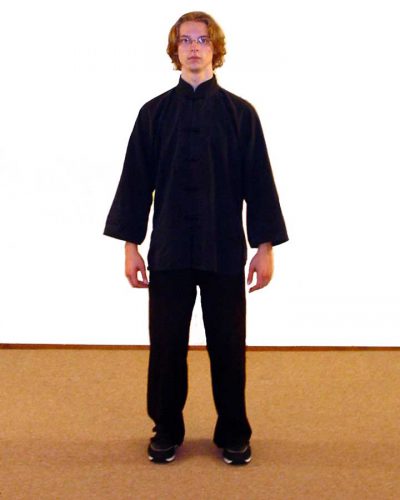 Beginners can train in warm up suits or jeans and T shirt for the first month after this we prefer that our students all wear the traditional black Chinese Han Zhifu for classes. A Han Zhifu is a training uniform known to many as Chinese martial arts uniform or Kung Fu clothing.
Beginners can train in warm up suits or jeans and T shirt for the first month after this we prefer that our students all wear the traditional black Chinese Han Zhifu for classes. A Han Zhifu is a training uniform known to many as Chinese martial arts uniform or Kung Fu clothing.
It is really the standard clothing worn by Chinese people during the Han Dynasty 206 B.C.–220 AD so Han Zhifu means Han uniform. A traditional Han zhifu is a pajama like uniform consisting of pants and jacket with a mandarin collar. Traditional old school zhifu were of plain cotton or other natural materials and were colored, grey, black, white or blue (we prefer the black for all beginning students).
A white or black undershirt either long or short sleeved devoid of pictures or slogans is worn beneath the jacket. Soft cotton sole cloth shoes rounded out the traditional uniform. Today our students are allowed to wear leather or canvas walking shoes, sneakers or deck shoes with rubber soles.
Wearing a traditional uniform reminds us of our heritage and is also a great social leveler. The millionaire can train next to the carpenter or the janitor and all look and are treated the same, as sincere students of Xinyiquan.
Local Supplier of Uniforms
Students can purchase Han Zhifu, shoes and shirts locally at Lang Son Traders run by our good friend Thang Hoa. The contact information is Lang Son Traders, Arlington, TX 76010 (817) 261-0065 Website http://www.langsontraders.com/

